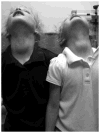Serendipitous identification of Graves' disease in identical twins with polydipsia
- PMID: 21714468
- PMCID: PMC4096950
- DOI: 10.1515/jpem.2010.208
Serendipitous identification of Graves' disease in identical twins with polydipsia
Abstract
Graves' disease in adolescents and adults usually presents with classic symptoms including weight loss, frequent stools, irritability, and heat intolerance. However, the clinical manifestations of hyperthyroidism in young children are often subtle, unrecognized, and atypical. Here, we report a 6 year-old girl who presented for evaluation of increased. thirst. Review of systems was negative with respect to weight loss, irritability, palpitations, diarrhea, and school performance problems. Physical exam was unremarkable except for an enlarged thyroid gland. Her identical twin sister, who incidentally accompanied her to clinic, also had a previously unidentified goiter. Testing for diabetes was negative. Further laboratory investigation was consistent with Graves' disease in both girls. Polydipsia is a rare and unusual presenting feature of hyperthyroidism in children. The evolution of this case highlights the importance of maintaining a high index of suspicion for thyroid disease during childhood.
Conflict of interest statement
The authors have no conflicts of interest to declare related to this report.
References
-
- Shulman DI, Muhar I, Jorgensen EV, Diamond FB, Bercu BB, Root AW. Autoimmune hyperthyroidism in prepubertal children and adolescents: comparison of clinical and biochemical features at diagnosis and responses to medical therapy. Thyroid. 1997;7:755–760. - PubMed
-
- Lazar L, Kalter-Leibovici O, Pertzelan A, Weintrob N, Josefsberg Z, Phillip M. Thyrotoxicosis in prepubertal children compared with pubertal and postpubertal patients. J Clin Endocrinol Metab. 2000;85:3678–3682. - PubMed
-
- Evered DC, Hayter CJ, Surveyor I. Primary polydipsia in thyrotoxicosis. Metabolism. 1972;21:393–404. - PubMed
-
- Andersen LF, Agner T, Walter S, Hansen JM. Micturition pattern in hyperthyroidism and hypothyroidism. Urology. 1987;29:223–224. - PubMed
Publication types
MeSH terms
Grants and funding
LinkOut - more resources
Full Text Sources

